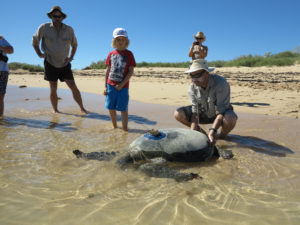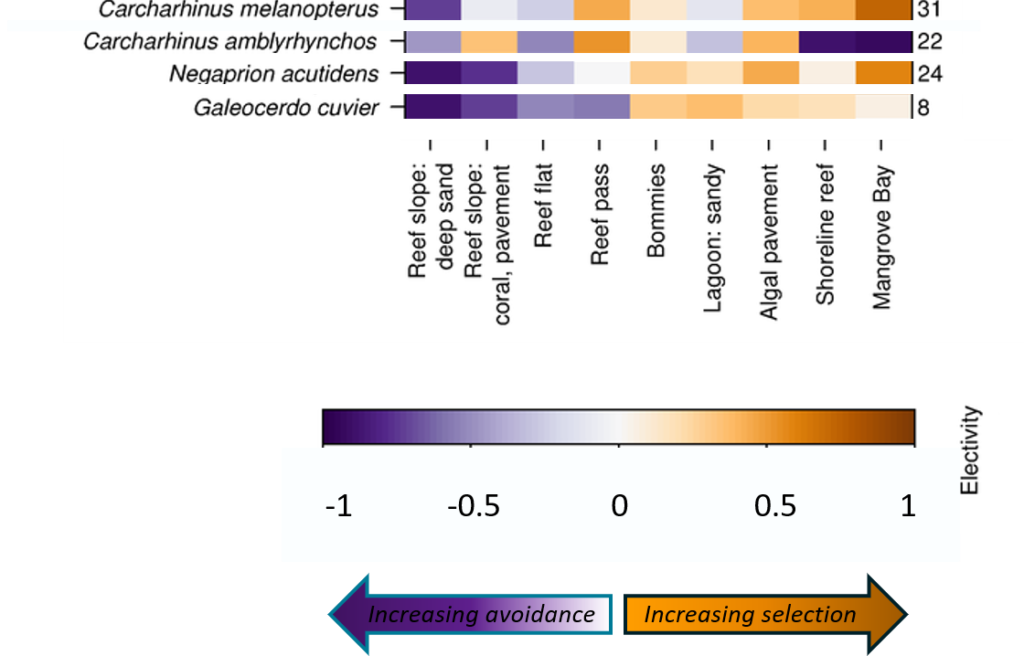Ecology of turtles and sharks
Ningaloo is home to marine turtles and sharks, which are among the region’s main attractions. Ningaloo is a globally-important location for several species, such as whale sharks and green turtles, but we know relatively little about the ecology of these wide-ranging species. The objective for this research theme (Ningaloo Outlook 2015-2020), led by Senior Research Scientists Dr. Mat Vanderklift and Dr. Richard Pillans, was to provide fundamental science to improve our knowledge, and to involve the local community in ways that increase their understanding, and participation in research.
Dr. Mat Vanderklift releasing a satellite tagged green turtle with the help of Cape Conservation Group volunteers (Image Credit: Richard Pillans CSIRO).
Ningaloo provides important habitat and important nesting areas for a number of marine turtle species, especially green Chelonia mydas and loggerhead Caretta caretta turtles. Ningaloo also hosts one of the world’s largest known aggregations of whale sharks (Rhincodon typus) each year between March and August. Ningaloo Reef supports large numbers of reef sharks and aggregations of reef sharks occur in some shallow nursery areas. Research has demonstrated that despite some species having similar diets, there is little overlap in space use between grey reef sharks, black tip reef sharks and lemon sharks.
A combination of different types of technology was used to tag and track the movements of turtles, whale sharks and coastal sharks during the project. A total of 94 tags (acoustic and satellite) were attached to turtles during the project, satellite tags alone yielded over 48 000 individual locations. Forty-six whale sharks were also tagged, and a further 48 acoustic tags deployed six species of coastal sharks. The movements of the satellite tagged animals were tracked to enable the scientists to better understand where these amazing creatures travelled.
The team’s initial focus for turtle tagging was on green turtles (Chelonia mydas), because this species nests along the beaches of the North West Cape in large numbers, and they are the most abundant species of turtle in the shallow waters of Ningaloo. The team showed that green turtles typically stayed within known feeding grounds, moving only short distances. The team also managed to successfully track two female green turtles during the entire nesting migration, from feeding grounds to nesting beaches and back.
The turtle tagging was done with the support of volunteers from the Exmouth community, including local school students. In addition to tagging, the team also set out to study what the turtles were eating, and in doing so discovered a non-invasive technique to collect data using nail clippings.
Whale shark with a satellite tow tag attached (Image Credit: Dr. Richard Pillans)
Tracking data for whale sharks showed that those tagged at Ningaloo tended to stayed in the eastern Indian Ocean, Arafura and Timor Seas. Some moved as far as Christmas Island, Indonesia, Timor Leste and the Gulf of Carpentaria, but most remained within 300-400 kilometres of Ningaloo. Each individual had its own unique pattern of movement, suggesting that they have developed their own strategy of finding sufficient food resources, including swimming thousands of kilometres in different directions.
DNA samples were also collected from whale sharks that visit the Ningaloo Reef to estimate their population size.
The study of the movement of multiple species of coastal shark also uncovered some interesting findings. Grey reef sharks were found to show the smallest home ranges (averaging around 3.5 km2), whilst tiger sharks tagged showed much larger home ranges (averaging around 13.4 km2). Although the coastal shark species studied ate similar prey (mainly fish), the team found that there was limited geographical overlap at Ningaloo, with each species having different habitat preferences.
Habitat preference of blacktip reef shark (Carcharhinus melanopterus), grey reef shark (Carcharhinus amblyrhynchos), lemon shark (Negaprion acutidens) and tiger shark (Galeocerdo cuvier) for nine habitat types within the Mangrove Bay acoustic array.
To find out more about the research findings from the tagging and tracking research theme, read our Ningaloo Outlook Highlight Report, which can be found here.
Future Scientists
A key element of the Ningaloo Outlook partnership has been to provide training opportunities for future scientists. Jessica Stubbs, our PhD Scholar for the Tagging turtles and sharks research theme, investigated novel methods to estimate the abundance and ecology of turtles in the Ningaloo Coastal World Heritage Area.



